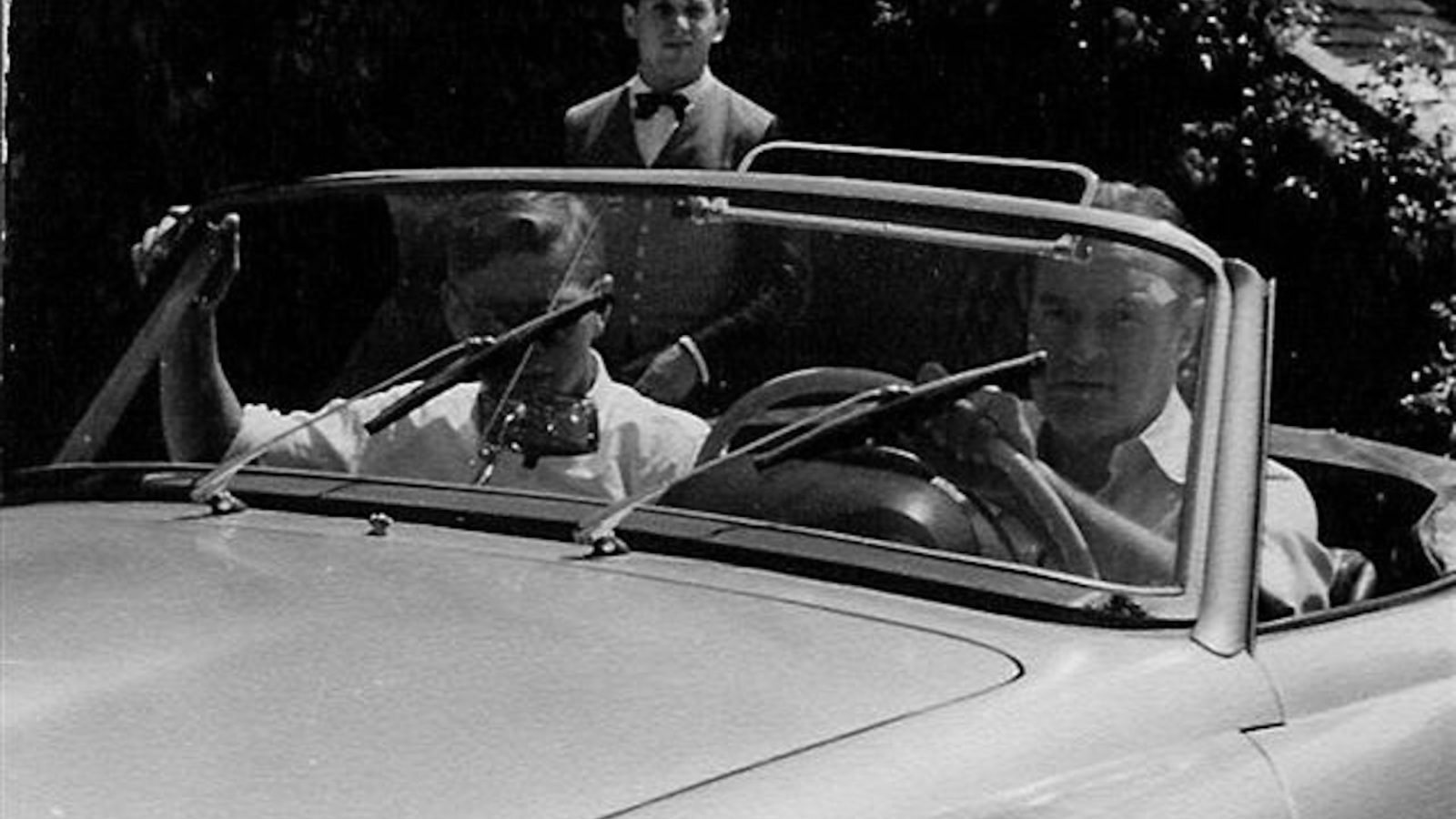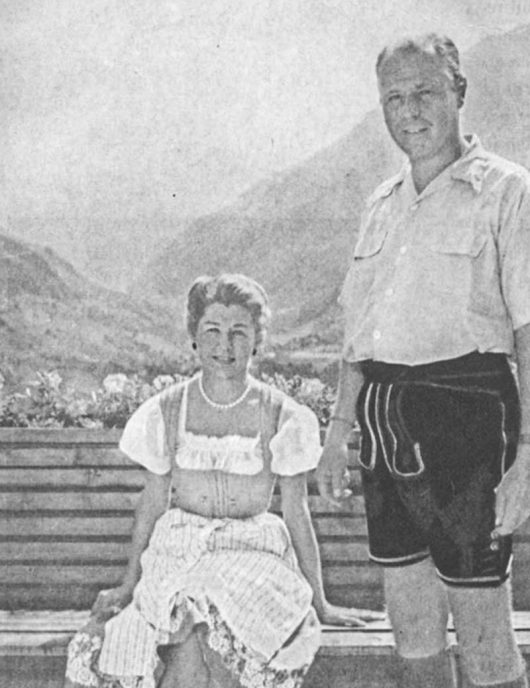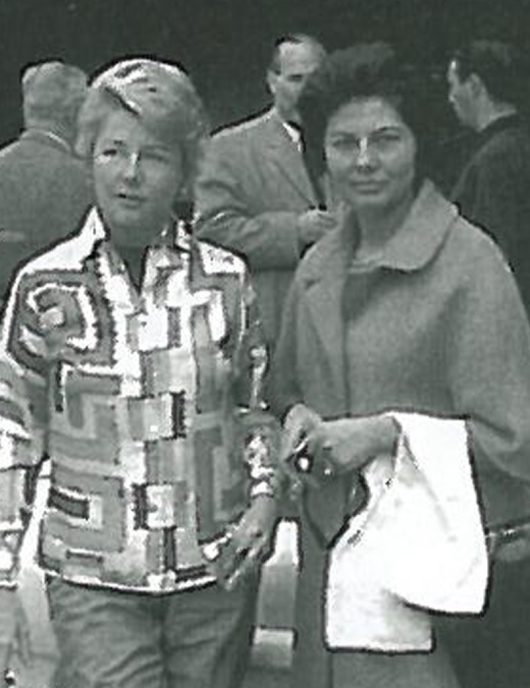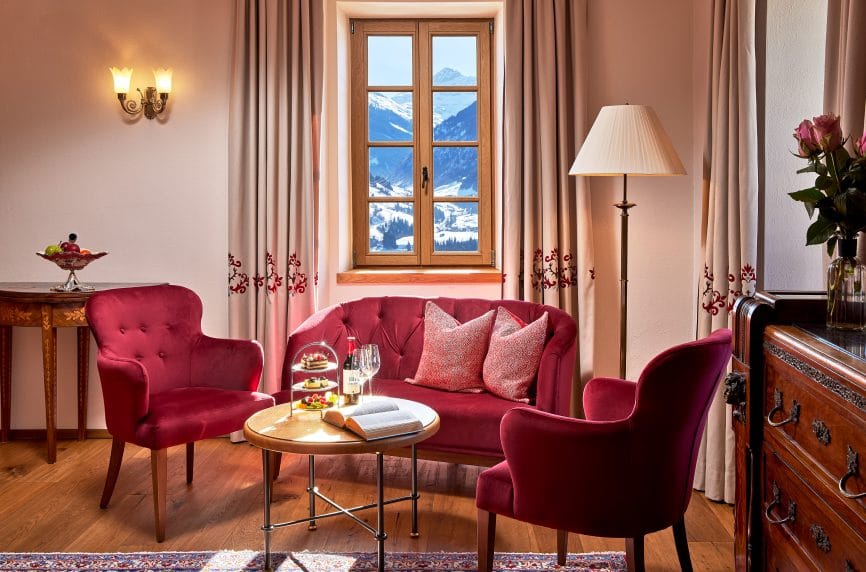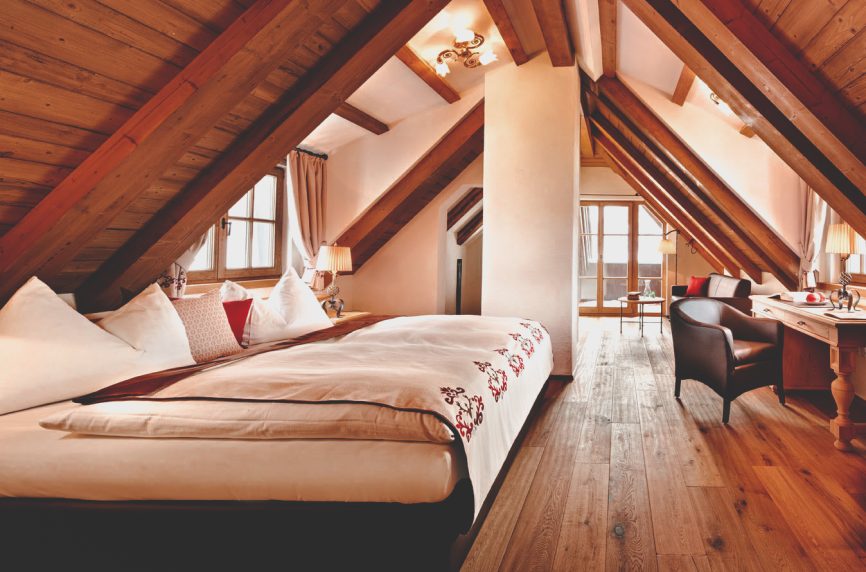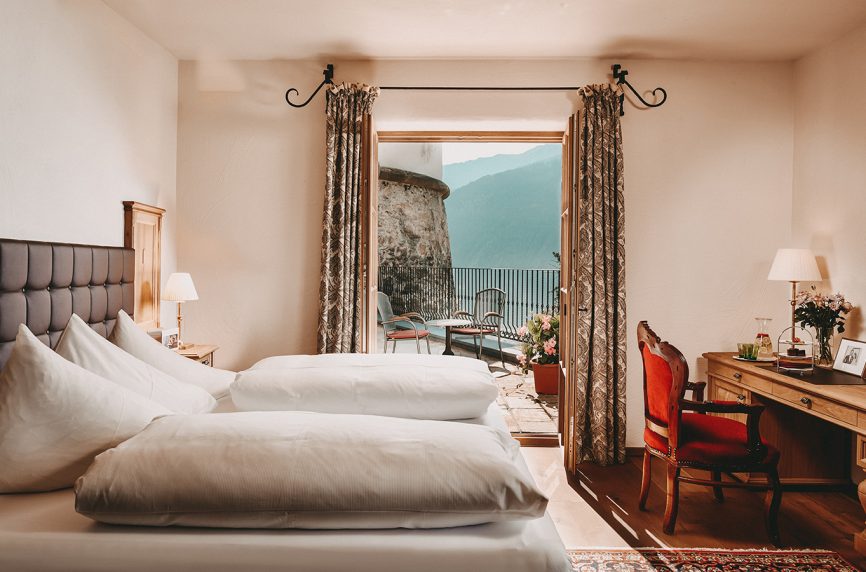Castle history
Hollywood stories from Salzburg
The history of Schloss Mittersill is fascinating and varied. The stories from its 900-year past open the door to the dreams and everyday life of bygone days. We share all sorts of interesting facts and intriguing stories about the stately castle in the province of Salzburg during our popular castle tours. If you listen and look closely during your vacation, the castle walls themselves itself will also reveal many a romantic tale.
The world’s most exclusive society club
In 1935 Baron Hubert von Pantz acquired Schloss Mittersill. In keeping with his lifestyle, his preferred pastimes and those of his equally illustrious and prominent friends from old Austrian nobility, Hubert von Pantz established the most exclusive society club in the world at Schloss Mittersill: the Sport & Shooting Club Mittersill. Even before the Second World War, everyone with rank and name in the international high society met there.

Once again feel the breath of noble times in old walls
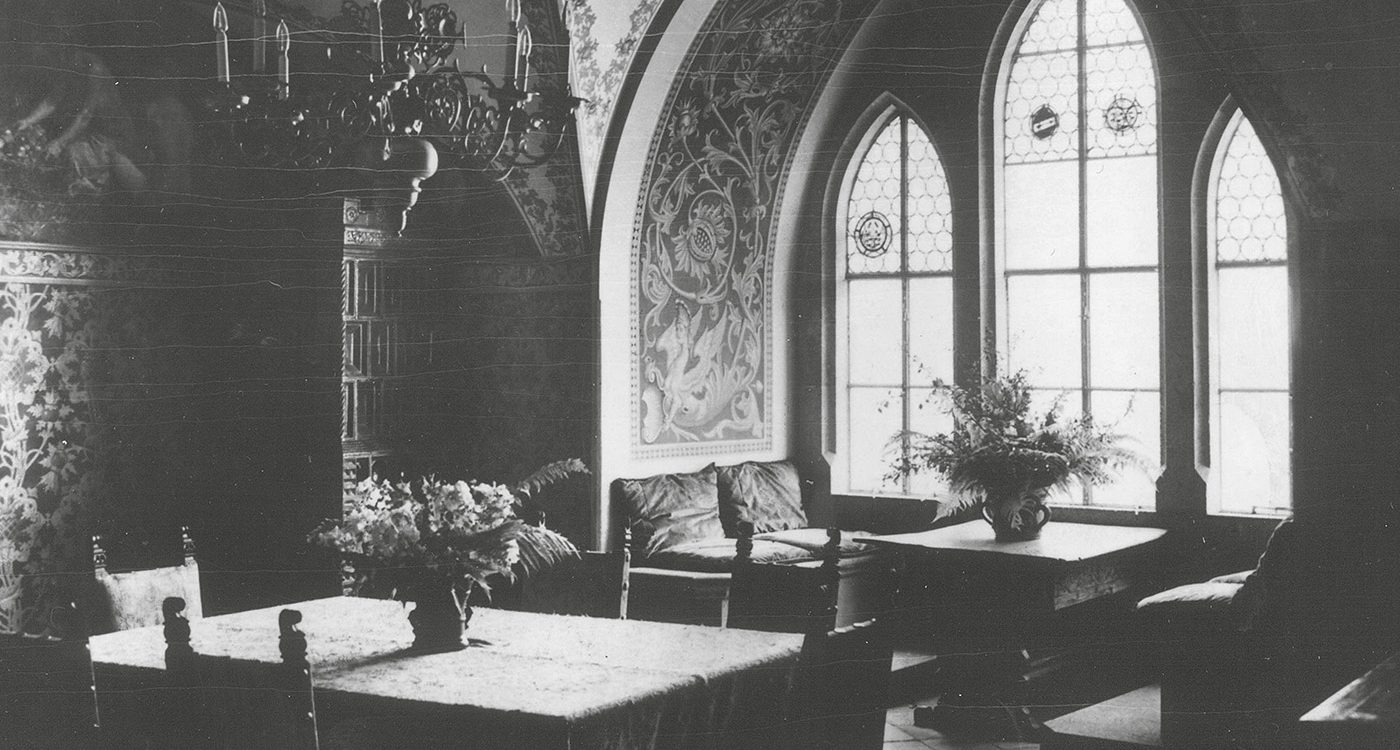
Schloss Geschichte
Wir erzählen bei den beliebten Schlossführungen allerlei Wissenswertes über die Geschichte des herrschaftlichen Schlosses im Salzburger Land. Wenn Sie während Ihres Urlaubs ganz genau hinhören und hinsehen, werden Ihnen auch die Schlossgemäuer so manch romantische Geschichte verraten.
Suite stories
The ten individually designed suites at Schloss Mittersill are linked to fascinating stories of celebrities and nobility from the last century. The historic walls are not only witnesses to former high-society encounters in our castle, but continue to exert unbroken fascination to this day.
The Persian fairytale princess from Germany
A fairytale like one from One Thousand and One Nights: This is the dazzling but melancholic life story of Princess Soraya of Persia. Soraya’s father came from one of Persia’s most distinguished and oldest tribal families. He was the imperial Persian ambassador to Germany from 1951 to 1961. In Berlin, he also met Soraya’s mother, the Moscow-born saleswoman Eva Karl.
Soraya was born on June 22, 1932 in Isfahan, the capital of the eponymous province in what was then Persia (now Iran). She spent her childhood in her native country as well as in Germany and Switzerland. She attended elite boarding schools in Montreux, Lausanne, and the Saint James boarding school in London. Soraya enjoyed excellent education and spoke four languages fluently: German, English, French and Persian.
Her fate was to be decided when the Shah of Persia’s mother, in search of a suitable wife for her son and monarch, Mohammad Reza Shah Pahlavi Shahanshah, took a liking to a photograph of Soraya. The Shah, too, fell in love with Soraya’s portrait. A wedding ceremony followed with glitz and glamour. Soraya got married in a silver Christian Dior wedding robe weighing no less than thirty kilograms. It seems that it was (in spite of the arrangement) a marriage of love, according to what both the Shah himself and Soraya later repeatedly suggested within the limits of permissible etiquette.
However, over the span of their seven-year-long marriage, no male heir to the throne was born (just as in Mohammed’s first marriage). The Shah therefore told the Persian radio station in a low voice and with “great sorrow” that due to state reasons he had separated from his “dear wife”. For Soraya, too, this separation was the only possible way forward. She could not have endured sharing her husband with a concubine necessary to produce an heir to the throne. The royal couple probably spent the happiest and most carefree days of their officially impossible love at Schloss Mittersill.
The life of Soraya proceeded to be as fateful as that of Princess Diana or Empress Elizabeth of Austria. Each of her steps was observed by the tabloids and commented on with great enthusiasm. She is said to have had affairs with the German playboy Gunter Sachs and the Austrian film actor Maximilian Schell. In fact, a great love of Soraya’s was the Italian film director Franco Indovina, with whom she was in a relationship until his tragic death in a plane crash in 1972. Frequently traveling and repeatedly suffering from depression, Princess Soraya died in her Parisian apartment on Avenue Montaigne on October 21, 2001. Soraya was laid to rest in the family grave in Munich’s Westfriedhof.
The extraordinary ordinary one
The future Queen of the Netherlands, Juliana, was born on April 30, 1909 in The Hague. She brought great joy to her parents, Queen Wilhelmina of Orange-Nassau and Prince Henry of Mecklenburg-Schwerin. Their marriage had long been childless and with their “Princess Sunshine”, as Juliana was called by her parents, the succession to the throne was assured.
Even as a child Juliana was rather modest and reserved, even a little shy. She grew up quite close to the common people. Like other kids, she skated on the frozen canals of The Hague. Of course, Juliana’s education up until university level was secured in private with royal tutors. However, she studied political science, against the initial resistance of her mother, at the public university in Leiden.
In 1936, Queen Juliana met the German Prince Bernhard zu Lippe-Biesterfeld at the Olympic Winter Games in Garmisch-Partenkirchen. The two fell in love, married in 1937 and spent their wonderful honeymoon at Schloss Mittersill that same year. Indeed, the Dutch royal couple regularly spent their winter vacation in Austria. Once they returned from the UK on September 6, 1948, Juliana was formally inaugurated as the Queen of The Netherlands.
Juliana’s heartfelt, social and down-to-earth personality (she refused to be called ‘Her Majesty’ and abolished the court curtsey) quickly won over the hearts and love of her people. One of the symbolically powerful moments of her reign, which lasted until 1980, took place in 1953. When the Netherlands was hit with a significant natural disaster she stood in black, heavy rubber boots in the middle of a flooded area—comforting and encouraging her people.
On March 20, 2004, Queen Juliana died in her sleep at the age of 94 from pneumonia. The then Dutch Prime Minister Jan Peter Balkenende praised her in his condolence speech with the following words: “Queen Juliana loved the people. She preferred spontaneity to protocol and honesty to formality, but in all that she did, she always remained a Queen who took her duty and mission very seriously. Queen Juliana was a warm-hearted, wise woman who dedicated her life to serving others. We remember her with love and gratitude.”
“I don’t do fashion. I am fashion.”
Coco Chanel – this name has long been legendary. It signifies elegance, luxury, lifestyle, liberation in fashion, and the emancipation of women. Time Magazine named Coco Chanel the only woman among the most influential personalities in the fashion industry of the 20th century. Gabriel Chasnel, Coco Chanel’s original name, was not given any of these attributes upon being born. On the contrary, Coco Chanel came from an impoverished background. She was born in 1883 in a French almshouse. Her father was unstable and unable to care for his family. So Coco Chanel spent her childhood in a strictly run orphanage. She slept in an unheated dorm and trained as a seamstress under the rigid regime of convent nuns.
With her ingenious talent and the financial help from her ever-changing and sometimes quite wealthy lovers in the financial aristocracy and the arts, Coco Chanel finally made it: from a humble beginning with a hat studio to fashion heaven. She revolutionized the world of women’s fashion. She literally freed style-conscious women from the corset’s confines and tightly wound fashion laws. Coco Chanel pioneered modern and functional women’s fashion with calf-length skirts or airy pants, loose-fitting tops and short haircuts for self-confident and independent women. She also set a high economic standard: Her perfume creation Chanel N°5 (also made famous by Marilyn Monroe) is still one of the world’s best-selling perfumes and has given rise to an entire industry.
Coco Chanel at Schloss Mittersill: inspired to design a masterpiece
Coco Chanel was already an icon in her day and embodied the lifestyle of high society like no other. At that time the owner of Schloss Mittersill, the aristocratic industrialist Baron Hubert von Pantz, established a hot spot for this elite circle in Salzburg. Coco Chanel was mesmerized by the castle’s charm, fell in love with it, and repeatedly spent many romantic days within its walls.
It was also here that she was inspired to design one of her most famous creations: the classic Chanel jacket. The uniform of one of the castle’s elevator boys was the inspiration for this timelessly beautiful and elegant garment, which to this day is a wardrobe essential for any successful businesswoman, actress or other female star around the globe.
It was not until the fall of 2014 that the fashion house Chanel and its then head creative director Karl Lagerfeld paid tribute to Salzburg. One of the highlights in a sparkling and glamorous fashion show was a tribute to the legendary Chanel jacket and its creation, which began at Schloss Mittersill. In order to pay homage to the dazzling Coco Chanel, a luxury suite was named after her in the four-star-superior Schloss Mittersill. We invite you to stay where Coco Chanel created one of the masterpieces of fashion.
The Italian Marilyn Monroe
‘Gina Nazionale’, or simply ‘La Lollo’, as she was later called by her fervent fans and admirers, was born on July 4 1927 in Subiaco near Rome. Already considered to be an extraordinarily beautiful child, she was crowned the ‘loveliest toddler in Italy’ at the age of three. In her later career Gina Lollobrigida was considered the epitome of sensual, seductive, Italian beauty; a femme fatale par excellence.
In her younger years, however, Lollobrigida (who received early private lessons in dance, singing and drawing) was more interested in painting and the visual arts. She studied sculpture and painting in Rome after the Second World War. In 2000, she mentioned in an interview for the magazine ‘Parade’: “I studied painting and sculpture at school and became an actress by mistake”.
This ‘mistake’ was a stroke of luck in the great, glamorous era of Hollywood cinema. After a rather modest beginning in Italy in 1952 she achieved her international breakthrough alongside Gérard Philipe with ‘Fanfan la Tulipe’ and ‘Beauties of the Night’.
Her most legendary roles were with Anthony Quinn in ‘The Hunchback of Notre Dame’, and the convincing demonstration of her singing talent in ‘The World’s Most Beautiful Woman’. Overall, Gina Lollobrigida participated in more than 70 film and television productions, establishing her worldwide fame as an actress and an icon of classic, feminine beauty.
Lollobrigida graced 6,000 magazine covers and received countless awards, including the Golden Globe.
In addition to acting Lollobrigida was also a successful photographer in the 1970s. She took portrait photographs of many different personalities such as Fidel Castro, Paul Newman, Salvator Dalí and Henry Kissinger. She also took up sculpture again and was accepted at the Academy of Arts in Florence.
She was married to the Yugoslavian doctor Milko Skofic for over 20 years and had a son, Milko Jr. Gina Lollobrigida was a coveted woman. This is no surprise, since she was surrounded by the most attractive and well-known men of her time (they were also often her film partners). Humphrey Bogart, Frank Sinatra, Kirk Douglas, Tony Curtis, Burt Lancaster and many others liked to be seen by her side. It goes without saying that ‘Gina Nazionale’ was the center of attention as both a guest and a welcome hunting companion for the high society gathered at Schloss Mittersill.
Lollobrigida has been working for UNESCO since the mid-1980s and has also been politically active. She currently lives in her beloved Italian capital of Rome.
“A gentleman forgets your age, but never your birthday.”
And Clark Gable truly was a gentleman. His austere and masculine charm drew masses of female admirers to the cinemas. He embodied the male macho ideal like no other. Clarke Gable was born on February 1, 1901 in the state of Ohio, USA. His mother died early, and so Gable grew up with relatives.
At the age of 16 he dropped out of high school and took on various odd jobs. His acting enthusiasm was first awoken by a touring theatre’s performance. His dream became quite clear: he wanted to be an actor, a path with many difficulties and obstacles. His first wife, the theater manager Josephine Dillon, opened the first doors for Gable in Hollywood. Gable took on some small roles and worked as an extra, but his breakthrough role in Hollywood materialized only after his theater success on New York’s Broadway.
Then it happened, all of a sudden: Signed to MGM, he later became the biggest star of the legendary film studio. He excelled in ‘A Free Soul’, and received the Academy Award for his brilliant performance in the 1934 comedy ‘It Happened One Night’. His performance in “Gone with the Wind” ensured immortality in the role of Rhett Butler. After volunteering in the Second World War with the US Air Force in England, Cable was able to build on his former triumphs with ‘The Misfits’ (with Marilyn Monroe). The five times married Clark Gable died on November 16, 1960 in Los Angeles from a heart attack.
Clark Gable visited Schloss Mittersill several times and was one of the world’s most famous personalities at the castle’s Sports & Shooting Club. His passion was for the beautiful things in life – and the game of golf. Those wanting to be reminded of this sporty, glamorous era can view Clark Gable’s golf bag at Schloss Mittersill.
He was the epitome of masculinity and a seductively macho lifestyle in his time. He acted alongside the most beautiful and famous actresses of his time and was a bon vivant. As such, of course, he fit very well into the elite circle of international high society brought together by the former owner of Schloss Mittersill, the aristocratic industrialist Baron Hubert von Pantz. In this illustrious circle, Gable was a highly valued and welcome guest. He knew how to entertain others with Hollywood anecdotes and stories about his famous co-stars. It was part of his lifestyle and image that there would always be more served than just one drink or one cigar. The great charmer Clark Gable was ranked seventh by the American Film Institute in their ‘List of the 25 greatest male movie legends of all time’.
The dynamics of a dynasty
Henry Ford the Second was the grandson of legendary automotive pioneer Henry Ford, who revolutionized the entire automotive industry in 1913 with the introduction of cars made on production lines. Ford’s Model T (also known as the ‘Tin Lizzy’) went down in industrial history, and sold over 15 million units in its virtually unchanged form from 1908 until 1927 – a record that would last for 45 years.
However, Henry Ford’s unwillingness to change would become a problem for his company. (His legendary saying was “Our customers can have the Model T in any color – as long as it is black.”)
New players appeared on the market, choice increased, and other manufacturers took customer requests into account when developing new cars. In short, Ford’s sales plummeted, and the company was almost ruined. In this difficult phase, the grandson of the company’s founder, Henry Ford II, born in 1917, took on the leadership of the company after the death of his father, Edsel Ford, who had been running the business.
Henry Ford the Second finally succeeded in bringing the Ford Company back into profit with his clever and rigorous management. On the one hand, Henry Ford II was a power-conscious patriarch, especially as he increased in age. On the other, the studied social scientist and philanthropist was also known throughout his life for having a charitable streak. He introduced significant improvements for his employees at all Ford factories and publicly supported the American social welfare system with donations and appropriate facilities.
Simultaneously, the thrice-married Henry Ford II was a bon vivant who loved women and life. Accordingly, he was part of the flourishing high society and of course, also one of Schloss Mittersill’s guests. Here Henry Ford II not only had the opportunity to enjoy his beloved parties, but also closed important contracts with influential business leaders from around the world. Needless to say, he also enjoyed the stylish and glamorous atmosphere international stars such as Clark Gable or Gina Lollobrigida brought to Schloss Mittersill. Henry Ford II was 70 years old when he died on September 29, 1987 at the Henry Ford Hospital in Detroit, USA.
Splendor, pomp and self-destruction
The reign of King Farouk I, then the most powerful monarch of the Middle East, began splendidly and promisingly. At the tender age of 17, Farouk I was crowned King of Egypt. His official title: ‘His Majesty Farouk I, by the grace of God, King of Egypt and the Sudan, Sovereign of Nubia, Kordofan and Darfur.’
Young, handsome, and intelligent, and equipped with the skills of an elite English education and training, he quickly became the most popular potentate of Egypt. He soon introduced social reforms and was quite popular and admired by his subjects. But the admiration for Farouk I extended even further than his own country. For example, the Prime Minister of Lebanon praised him by saying, “He is not only the king of Egypt, but the king of all Arabs.”
However, this popularity quickly waned. In fact, the king’s desire for luxury, splendor and entertainment became increasingly exorbitant and limitless. More and more he cultivated an extravagant and unbridled lifestyle, unconstrained by any social conventions: luxury cars, estates, palaces, gold, diamonds, love affairs, eating and drinking.
On July 23, 1952 Faruk was overthrown by a military coup organized by General Mohammed Naguib and Gamal Abdel Nasser. He initially took asylum in Monaco and later in Italy, and Farouk I continued his pompous lifestyle in Europe. His eccentric performances and his bets in Europe’s most sophisticated casinos provided dazzling material for the tabloids.
Farouk, however, also had a different side. One side of him was considered cultivated, civilized and educated. It is said that he spoke Arabic, Turkish, Italian, English, French, German, and Russian. The charming variety of Farouk’s ambivalent personality was also shown at banquets and in the company of the international high society in the Sport & Shooting Club at Schloss Mittersill.
King Farouk I was married twice. He had three daughters with Queen Farida (real name: Safinaz Zulficar, whom he married in 1938, and divorced in 1948). He had a son with Narriman Sadek (a commoner who after their marriage in 1951 was called ‘Cinderella of the Nile’, and whom Farouk divorced in 1954) named Ahmed Fuad. King Farouk I was only 45 years old when he died on March 18, 1965 in Rome.
Happiness is stronger than iron.
The former lord of Schloss Mittersill and founder of the world’s most exclusive society of its day, Baron Hubert von Pantz, was one of the most dazzling personalities of 20th century international high society. Hubert von Pantz came from one of the oldest noble families in Austrian history. The family tree of the von Pantz family dates back to the Holy Roman Empire of the 15th century. Their title of nobility, which granted the von Pantz family a monopoly on iron mining throughout Central Europe, also dates back to this period.
Hubert von Pantz was born on 5 July 1909 in Sonnhof ob Stainach near Liezen in Styria. He spent his coming-of-age years in a time of excess – the 1920s after the First World War. This war had dissolved the monarchy and Austria had shrunk from a prosperous empire 65 million people to a small country with six million inhabitants. Therefore, the nobility was looking to find themselves and a new world stage. Hubert von Pantz found this as a VIP of an international high society circle.
In 1935, Baron Hubert von Pantz acquired Schloss Mittersill and later established the most exclusive sports and society club of its day: the Sports & Shooting Club Mittersill. Baron Hubert von Pantz’s connections and acquaintances, who visited him at Schloss Mittersill, spending exclusive vacations there, ranged from the House of Windsor to the Dutch royal family and the Shah of Persia. Hollywood stars such as Clark Gable, Rita Hayworth and Gina Lollobrigida were also happily seen in the company of the young, elegant and cosmopolitan Baron. Coco Chanel succumbed to his charm, and during one of her visits at her lover’s Schloss Mittersill was inspired to design her timeless fashion classic, the Chanel jacket.
During the Second World War, while Schloss Mittersill was appropriated by the dictatorship, Baron Hubert von Pantz realized his dream of Schloss Mittersill in America. In Franconia, New Hampshire, the Mittersill Alpine Resort was built in authentic Tyrolean architecture, opening its doors in 1945. It was an immediate success and became a beloved meeting place for American high society.
But Hubert von Pantz also re-established Schloss Mittersill in Salzburg as an elite society hotspot with his exclusive Sport & Shooting Club Mittersill, and brought the international high society back to Austria. The Shah of Persia, Soraya, King Farouk of Egypt, the Duke of Windsor, Aristotle Onassis, Aga Khan, Henry Ford II, Rita Hayworth, Gina Lollobrigida, Clark Gable, Bob Hope, Bing Crosby and many others repeatedly signed the guest book at Schloss Mittersill, paying their respects to Baron Hubert von Pantz.
King of comedians, television and radio star
For many, Bob Hope is still the most gifted of all American entertainers and comedic actors. Born in the UK in 1903, he started his international career in America. He jokingly said that he had left England at the age of four after realizing that he could not become king there. Early on, his mother (a professional singer) inspired him to join show business. At first, he struggled as an amateur boxer and unskilled worker, but his exceptional talent as a comedian became evident quite early on.
Subsequently Hope starred in several Broadway musicals, countless movies and later became a television and radio star. He was awarded over 1,500 prizes over his incredible career. He still maintains his record as the most awarded entertainer. Among other awards he received five Academy Awards—not official, but honorary. On the Hollywood Walk of Fame, he is represented with no less than four stars: for the categories of film, television, radio and theatre. His popularity also increased when he displayed his patriotic commitment while accompanying American troops during various wars.
Apart from show business, golf was Bob Hope’s greatest passion. He is probably the only person who has played a round with American presidents Dwight D. Eisenhower, Ronald Reagan, George Bush and Bill Clinton. For his contributions to the sport of golf, he was inducted into the World Golf Hall of Fame.
Hope also honored the small golf course of the Sport & Shooting Club Mittersill, which was cost-effectively and personally designed by Schloss Mittersill’s owner Baron Hubert von Pantz, and Bob Hope seemed to be quite taken by it. Bing Crosby also played on this course. This golf initiative at Schloss Mittersill marked the beginning of the later Golf Club Kitzbühel, which is known today far beyond Austria’s borders.
Bob Hope was married to his wife Dolores for over 69 years until his death at the age of 100 in California. He had four children with Dolores.
Alexander Prinz zu Hohenlohe-Waldenburg-Schillingsfürst, also known as Alexander von Hohenlohe, was born on August 6 1862 in Lindau, the son of Chlodwig Fürst zu Hohenlohe-Schillingsfürst. The extensive family tree of the German noble family of Hohenlohe goes back to 1153. Alexander von Hohenlohe’s father Chlodwig was one of the most influential politicians of his time. From 1894 to 1900 he was Chancellor of the German Reich and Prime Minister of Prussia.
His son Alexander von Hohenlohe was also to devote his life to politics, diplomacy and journalism. Alexander von Hohenlohe attended grammar school in Wiesbaden and then studied law at the universities of Graz, Vienna, Paris, Leipzig and Göttingen. In 1886 he became an imperial clerk responsible for the administration of Alsace-Lorraine in Strasbourg where his father was Reich Governor at that time. However, Alexander managed this without having passed his state examination and therefore lacking a law degree.
After his father had been promoted to Chancellor of the Reich, Alexander followed him to Berlin and was the imperial legation councilor and an employee at the ministry for foreign affairs in Berlin from 1894 to 1898. In May 1898, his father continued his appointment as the Imperial District President for Upper Alsace in Colmar.
From 1893 to 1903 Alexander was a member of the German parliament for the constituency of Alsace-Lorraine 10 (Hagenau, Weissenburg). In parliament he was first a member of the Reich Party, was elected in 1898 as a candidate of the German Conservative Party, and finally as an independent. In 1903 he ran as an independent conservative but lost narrowly in the runoff election.
Alexander von Hohenlohe’s socially liberal attitude earned him the nickname “Red Prince”. He loved passionately discussing his ideas on this topic with the aristocrats and high society circles at Schloss Mittersill. However, Prince Alexander von Hohenlohe also found that during his lengthy stays at Schloss Mittersill’s Sport & Shooting Club, he had time to relax, gather strength and pursue his hobbies. So it was that Alexander von Hohenlohe, alongside Baron Hubert von Pantz, represented the agendas of the Sport & Shooting Club Mittersill at the founding meeting of the Kitzbühel Golf Club, and his initiative was instrumental for the final planning and execution of the Kitzbühel Golf Club.
Politically, Alexander von Hohenlohe preserved his revolutionary spirit. This was very evident when, after the death of his equally liberal-minded father, he printed his memoirs, against the express wish of the Emperor. The Emperor then forced his resignation as District President.
Later, Alexander Prinz zu Hohenlohe-Waldenburg-Schillingsfürst lived in Switzerland. Alexander von Hohenlohe died in 1924 after a long illness living in poor conditions in Badenweiler in Baden-Württemberg.


